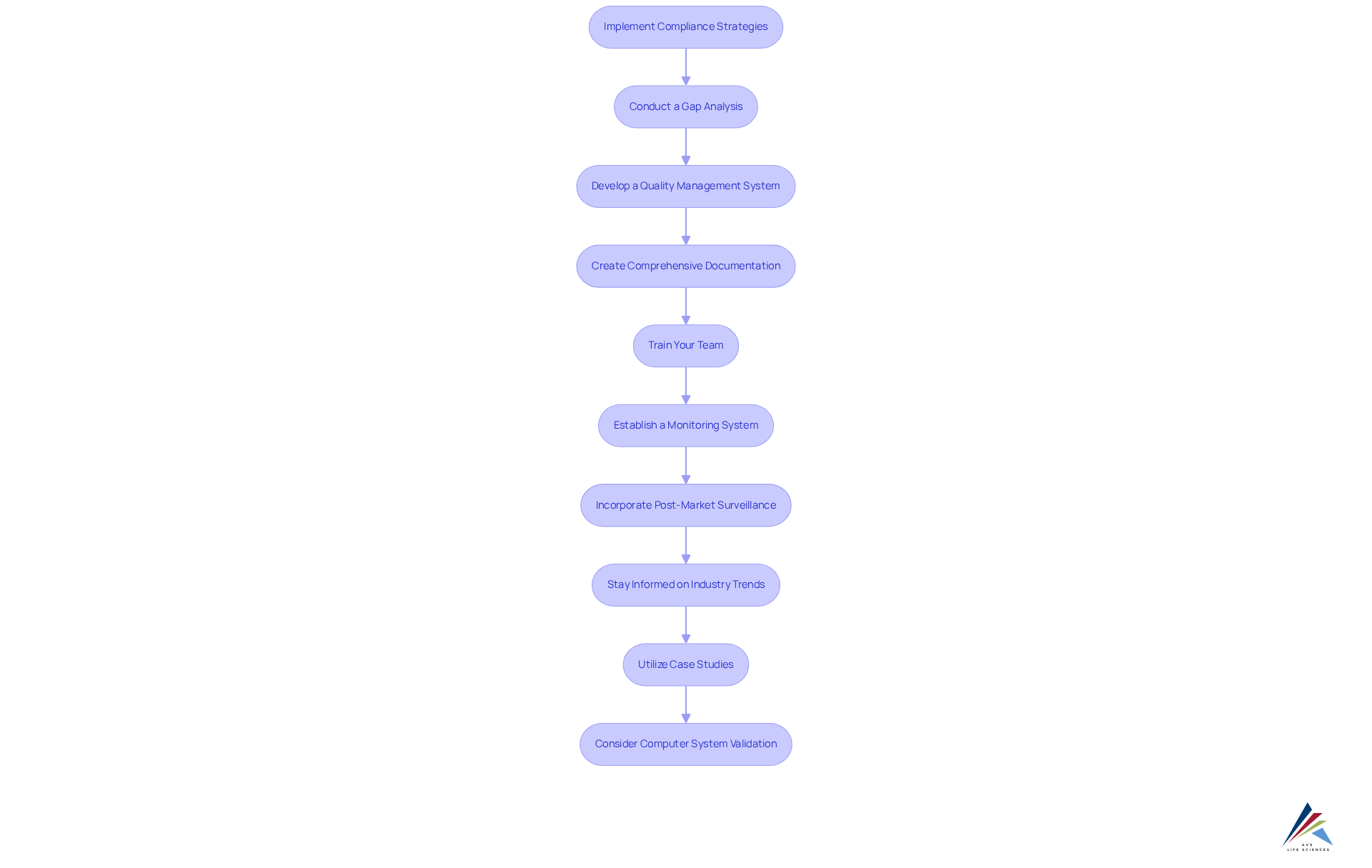Master 21 CFR Part 4: Essential Compliance Steps for Officers

Overview
Mastering 21 CFR Part 4 is essential for officers, necessitating a thorough understanding of the regulation's key principles. Compliance challenges are significant, yet they can be effectively addressed through strategic actions. Officers must conduct comprehensive gap analyses and develop robust quality management systems specifically tailored to drug-device combination products.
To navigate these compliance challenges successfully, it is crucial to implement specific strategies:
- Training personnel to ensure they are well-versed in regulatory requirements
- Maintaining comprehensive documentation that reflects compliance efforts
- Engaging with external experts who can provide valuable insights
These steps not only facilitate adherence to regulatory standards but also position organizations for success in a complex compliance landscape. By taking decisive action now, officers can ensure their organizations remain compliant and competitive.
Introduction
Mastering the intricacies of 21 CFR Part 4 is essential for compliance officers navigating the complex landscape of drug-device combination products. This regulation delineates the FDA's expectations for quality systems, necessitating a comprehensive understanding and implementation of compliance strategies.
With the anticipated market growth projected to reach $23.6 billion by 2033, organizations face the pressing challenge of aligning their practices with evolving regulatory demands.
How can they effectively overcome the inherent obstacles to adherence? This article will explore actionable insights and solutions to ensure compliance in a dynamic environment.
Understand 21 CFR Part 4: Key Principles and Requirements
To effectively master 21 CFR Part 4, compliance officers must first familiarize themselves with its . This regulation outlines the FDA's expectations for the quality systems of combination items, which include both drugs and devices. The essential steps to understanding this regulation are as follows:
- Familiarize with the regulation by beginning with 21 CFR Part 4 to grasp its scope and applicability. Focus on definitions, general requirements, and specific provisions related to combination products.
- Identify Key Components: Pay attention to critical elements such as quality system requirements, design controls, and risk management processes that are essential for meeting the standards.
- Consult FDA guidance documents that elaborate on 21 CFR Part 4, providing insights into the agency's expectations and interpretations of this regulation.
- Engage with training resources by utilizing training programs and workshops that focus on 21 CFR Part 4 to deepen your understanding and stay updated on any changes or clarifications in 21 CFR Part 4.
- Network with peers by joining industry forums or groups where regulatory officers discuss challenges and share insights related to 21 CFR Part 4. This engagement enhances your practical understanding through shared experiences.

Implement Compliance Strategies for Drug-Device Combination Products
To effectively implement compliance strategies for drug-device combination products under 21 CFR Part 4, the regulations outlined in 21 CFR Part 4 are crucial for compliance. Organizations must follow these essential steps:
- Conduct a Gap Analysis: Evaluate your existing quality systems against the stipulations of 21 CFR Part 4 to identify areas that need improvement. This analysis should concentrate on recognizing discrepancies between current practices and compliance expectations.
- Develop a Quality Management System (QMS): Create a robust QMS that harmonizes the requirements of both drug and device regulations. This system should encompass all aspects of product development and manufacturing, ensuring thorough adherence. AVS Life Sciences provides expert solutions in quality management, ensuring your QMS complies with all compliance standards, including GXP practices.
- Create comprehensive documentation: Maintain thorough records demonstrating adherence to 21 CFR Part 4. This includes essential records such as design history files, risk management plans, and validation protocols, which are critical for demonstrating adherence to regulatory standards. AVS Life Sciences highlights excellent documentation practices to aid your adherence efforts.
- Train Your Team: Implement targeted training programs for your personnel to ensure they are well-versed in regulatory requirements and understand their responsibilities in upholding adherence to 21 CFR Part 4. Ongoing education promotes a within the organization, a principle that AVS Life Sciences advocates through its consulting services.
- Establish a Monitoring System: Create a system for continuous oversight and evaluation of adherence initiatives. This proactive approach allows for the prompt recognition and correction of any conformity issues, ensuring continuous adherence to standards. AVS Life Sciences can assist in setting up effective monitoring systems tailored to your needs.
- Incorporate Post-Market Surveillance: Emphasize the importance of post-market surveillance as part of your compliance strategy. Ongoing assessment of performance and safety is crucial for managing risks linked to drug-device combination items, particularly considering the complexities emphasized in recent regulatory discussions.
- Stay Informed on Industry Trends: Keep abreast of current trends in quality management systems for drug-device combinations, including the challenges posed by wearable combinations. Grasping these trends can assist you in modifying your regulatory strategies accordingly.
- Utilize Case Studies: Reference relevant case studies that demonstrate the intricacies of adherence to regulations for combination products. For instance, insights from the EU MDD to MDR transition can provide practical examples of navigating regulatory challenges. AVS Life Sciences' extensive experience in biopharmaceuticals and medical devices positions it as a valuable resource for understanding these transitions.
- Consider Computer System Validation: Incorporate the computer system validation process into your regulatory strategy. This multi-step process guarantees that software and software-controlled systems function as intended, which is essential for upholding standards in drug-device combination offerings.
By adhering to these steps, organizations can efficiently manage the intricacies of rules for drug-device combinations, aligning their practices with the changing legal framework. As the market for drug-device combination products is anticipated to hit $23.6 billion by 2033, the need for strong adherence strategies has never been more pressing.

Overcome Compliance Challenges: Practical Solutions and Best Practices
Navigating various challenges is essential for organizations to achieve compliance with 21 CFR Part 21 cfr part 4. To effectively overcome these obstacles, consider the following practical solutions and best practices:
- Stay Updated on Policy Changes: Regularly monitor updates from the FDA and other governing organizations to remain informed about changes that may impact adherence requirements.
- Utilize Technology: Implement management software designed to streamline documentation, training, and monitoring processes, facilitating the maintenance of high standards. For instance, AVS Life Sciences demonstrated this by ensuring complete traceability during a recent enhancement of a biotechnology GMP facility, which was critical for meeting compliance standards and preventing anomalies in test results.
- Foster a Regulatory Culture: Cultivate a culture of adherence within your organization by promoting open communication regarding regulatory expectations and the significance of compliance. The collaboration with AVS Life Sciences highlighted the value of team discussions about responsibilities and workload, essential for maintaining standards and addressing emerging issues.
- Conduct Regular Audits: Schedule internal reviews to assess compliance with 21 CFR Part 21 cfr part 4, pinpointing areas for improvement and ensuring that corrective actions are taken promptly. The case study from AVS Life Sciences illustrates how regular evaluations can uncover process gaps affecting test results, such as the anomalies identified during testing due to improperly installed barcode scanner cameras.
- Engage External Experts: Consider enlisting outside consultants or specialists, such as those from AVS Life Sciences, to gain additional insights and support in navigating complex regulatory challenges. Their is invaluable for overcoming obstacles and ensuring adherence to established standards.

Conclusion
Mastering 21 CFR Part 4 is imperative for compliance officers navigating the complexities of drug-device combination products. This regulation delineates the FDA's expectations regarding quality systems, necessitating a comprehensive understanding of its key principles and requirements. By concentrating on the critical elements outlined in the regulation, officers can ensure their organizations meet the essential standards for compliance and uphold product integrity.
Throughout this article, several key strategies have been illuminated to facilitate effective compliance. These encompass:
- Conducting gap analyses
- Developing robust quality management systems
- Maintaining thorough documentation
- Fostering a culture of adherence within the organization
Additionally, remaining informed about policy changes and leveraging technology can significantly enhance compliance efforts. Engaging with external experts can also yield valuable insights and support in overcoming regulatory challenges.
In conclusion, the significance of 21 CFR Part 4 is paramount, especially as the market for drug-device combination products continues to expand. Organizations must prioritize compliance not only to meet regulatory expectations but also to ensure the safety and efficacy of their products. By implementing the outlined strategies and best practices, compliance officers can adeptly navigate the regulatory landscape, ultimately contributing to the success and integrity of their organizations in this evolving field.
Frequently Asked Questions
What is 21 CFR Part 4?
21 CFR Part 4 is a regulation that outlines the FDA's expectations for the quality systems of combination items, which include both drugs and devices.
What are the key principles of 21 CFR Part 4?
The key principles include understanding the regulation's scope and applicability, focusing on definitions and general requirements, and specific provisions related to combination products.
What critical elements should compliance officers pay attention to in 21 CFR Part 4?
Compliance officers should pay attention to quality system requirements, design controls, and risk management processes that are essential for meeting the standards.
Where can compliance officers find additional guidance on 21 CFR Part 4?
Compliance officers can consult FDA guidance documents that elaborate on 21 CFR Part 4, providing insights into the agency's expectations and interpretations of the regulation.
How can compliance officers enhance their understanding of 21 CFR Part 4?
They can utilize training programs and workshops that focus on 21 CFR Part 4 to deepen their understanding and stay updated on any changes or clarifications.
What is the benefit of networking with peers regarding 21 CFR Part 4?
Networking with peers through industry forums or groups allows regulatory officers to discuss challenges and share insights, enhancing their practical understanding through shared experiences.
